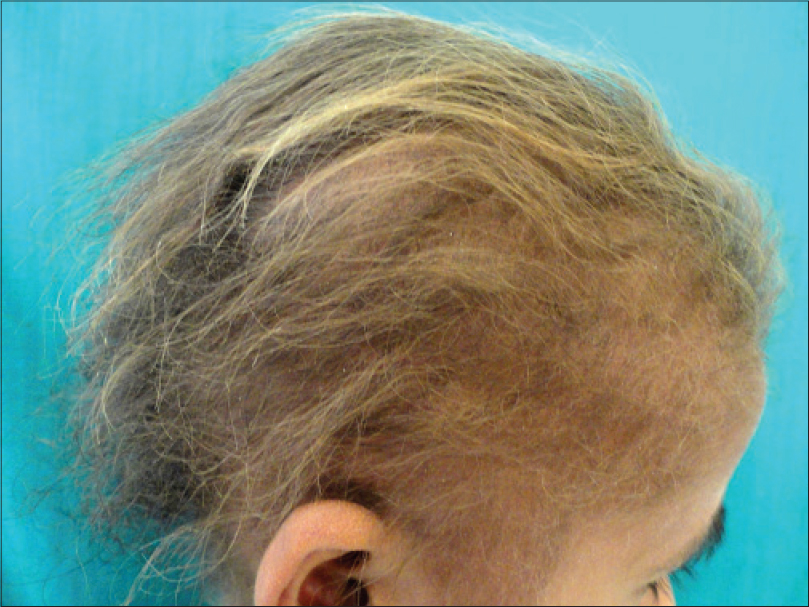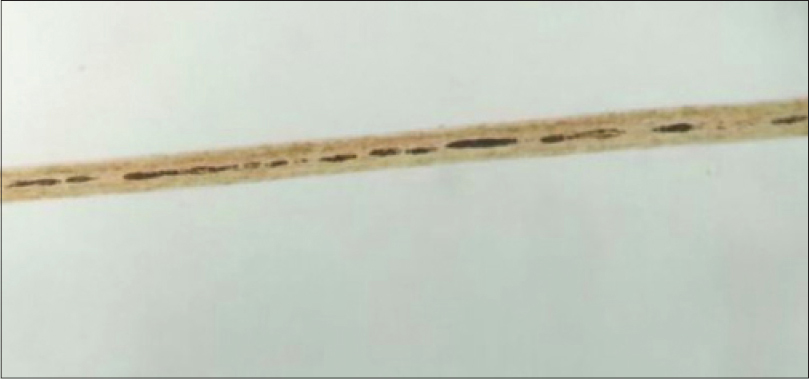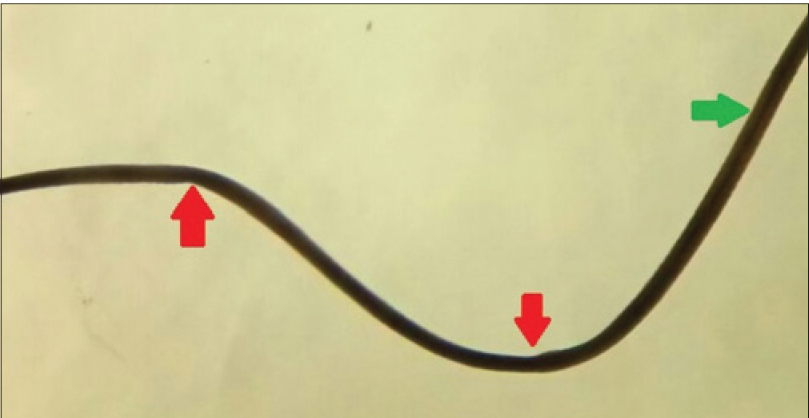Translate this page into:
Uncombable hair syndrome with a woolly hair nevus
Correspondence Address:
B C Ravikumar
Department of Dermatology, Venereology and Leprology, Hassan Institute of Medical Sciences, Hassan - 573 201, Karnataka
India
| How to cite this article: Swamy SS, Ravikumar B C, Vinay K N, Yashovardhana D P, Aggarwal A. Uncombable hair syndrome with a woolly hair nevus. Indian J Dermatol Venereol Leprol 2017;83:87-88 |
Sir,
Abnormalities of the hair shaft associated with unruly hair include uncombable hair syndrome and woolly hair.[1] Uncombable hair syndrome is an inherited autosomal dominant trait or a sporadic structural hair abnormality.[2] Clinically, the hair is dry, coarse, usually blond to light brown with a tangled appearance. The scalp hair is frizzy and unmanageable, growing in multiple directions, and cannot be combed flat.[1]
'Woolly hair' refers to tightly coiled hair covering the whole scalp or part of it, in a non-negroid individual. These hairs tend to be unruly, curly, lighter in color and smaller in diameter than the surrounding normal hair without an increase in fragility and appear to be sparse. A woolly hair nevus is a well-circumscribed patch of such tightly coiled hair.[3]
We report a patient with the rare coexistence of both these hair shaft abnormalities.
A 10-year-old girl born to third-degree consanguineous parents presented to us with a complaint of abnormal hair from the age of 2 years. The child was born with normal black hair all over the scalp. At the age of 2 years, the entire scalp was shaved bald as part of a religious ceremony. The mother noticed that the new hair that grew all over the scalp was light-colored and dry, sticking out of the scalp and was not combable. She also noticed that the new hair did not grow long. For the past 3 years, additional changes were noted in the hair on the back of the scalp which became darker and shorter than the rest of the hair; it was also coiled. The child's developmental milestones were not delayed and there was no physical or mental retardation. Photosensitivity was not reported. There was no personal or family history of cutaneous disease.
On clinical examination, hair on the entire scalp but for a patch on the occipital region was dry, lighter in color (blond to light brown), sticking out of the scalp and could not be combed flat [Figure - 1]. On the occipital region, there was a well-circumscribed patch (11 cm × 7 cm) of curly, coiled hair, darker and shorter than hair on the rest of the scalp [Figure - 2]. There were no cutaneous lesions elsewhere on the body. Teeth, nails, palms and soles were normal. Hair on the eyebrows and eyelashes were also normal. There were no ocular, cardiac, neurologic or skeletal defects.
 |
| Figure 1: Uncombable hair (side view) |
 |
| Figure 2: Woolly hair nevus (occipital region) |
Electrocardiography, echocardiography, routine blood investigations and urine examination were normal. Light microscopy of the uncombable hair showed light brown pigment [Figure - 3]a. Light microscopy of hair from the woolly hair nevus showed normal black pigmentation and non-specific changes such as partial twists and irregularity of bore and features of trauma (trichoptilosis) [Figure - 3]b and [Figure - 3]c. The characteristic structural defects in both types of hair could not be appreciated on light microscopy. Scanning electron microscopy was not performed as it was not available to us.
 |
| Figure 3a: Uncombable hair showing light brown pigmentation (×400) |
 |
| Figure 3b: Woolly hair showing, kinking of hair shaft (red arrows) and irregularity of shaft diameter (green arrows) (×100) |
 |
| Figure 3c: Woolly hair showing features of trauma (trichoptilosis) (×400 ) |
Oral biotin, 5 mg once daily was started. The patient and her parents were counseled about the benign and chronic nature of the condition. The patient is being reviewed regularly.
Uncombable hair syndrome, also named pili trianguli et canaliculi, cheveux incoiffables or spun-glass hair, is a rare structural anomaly of the hair shaft.[2] It may first become obvious from 3 months to 12 years of age.[2] It is suggested that the misshapen dermal papilla alters the shape of the inner root sheath which hardens (before the hair within) in a triangular cross-sectional shape, and the hair then hardens into a shape complementing the root sheath.[2] Diagnosis is suspected clinically and confirmed by scanning electron microscopy.[3]
Hair in a woolly hair nevus tends to be unruly, curly, lighter in color and smaller in diameter than the surrounding normal hair without an increase in fragility, and appears to be sparse; all features noted in our patient. The hair may be fine in infancy becoming coarser with age, especially at puberty. The hair shaft shows partial twists, grooves, irregularity of bore and sometimes, trichoptilosis.[2]
Uncombable hair syndrome is reported to be associated with loose anagen syndrome and ectodermal dysplasia.[1] Woolly hair nevus has been associated with melanocytic or epidermal nevi and Mongolian spots.[4] We did not find any previous reports of an association of uncombable hair syndrome and woolly hair nevus.
Financial support and sponsorship
Nil.
Conflicts of interest
There are no conflicts of interest.
| 1. |
Otberg N, Shapiro J. Hair growth disorders. In: Goldsmith LA, Katz SI, Gilchrist BA, Paller AS, Leffell DJ, Wolff K, editors. Fitzpatrick's Dermatology in General Medicine. 8th ed. Philadelphia: McGraw Hill; 2008. p. 1004.
[Google Scholar]
|
| 2. |
Messenger AG, De Berker DA, Sinclair RD. Disorders of hair. In: Burns T, Breathnach S, Cox N, Griffiths C, editors. Rook's Textbook of Dermatology. 8th ed. West Sussex: Wiley-Blackwell; 2010. p. 66.70-72.
[Google Scholar]
|
| 3. |
Hicks J, Metry DW, Barrish J, Levy M. Uncombable hair (cheveux incoiffables, pili trianguli et canaliculi) syndrome: Brief review and role of scanning electron microscopy in diagnosis. Ultrastruct Pathol 2001;25:99-103.
[Google Scholar]
|
| 4. |
Venugopal V, Karthikeyan S, Gnanaraj P, Narasimhan M. Woolly hair nevus: A rare entity. Int J Trichology 2012;4:42-3.
[Google Scholar]
|
Fulltext Views
7,263
PDF downloads
2,513





